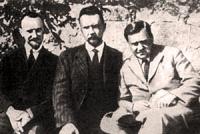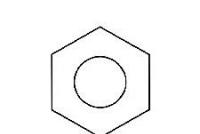Classically distinguished aromaticity. Aromatic in carbohydrates. Methods for the synthesis of small cycles
Chemistry is the heart of science. She's playing all the speeches, yakі іsnuyuet in nature, and їх impersonal. The stench is subdivided into inorganic and organic. In this article, it is clearly aromatic in carbohydrates, which lie down to the rest of the group.
What is it?
Tse organic speech, yakі may have in their warehouse one or a few benzene nuclei - stable structures of six atoms of carbon, z'ednah in the bagatokutnik. Given the chemical composition, there is a specific smell, which can be understood from its name. In carbohydrate groups, the groups are considered to be cyclic, on the top of alkanes, alkynes and others.
Aromatic in carbohydrates. Benzene
This is the simplest chemistry for the whole group of speeches. Six atoms of carbon and steel and hydrogen enter into the warehouse of one of the molecules. All other aromatic carbohydrates are similar to benzene and can be removed from this extract. Tsya speech, with normal minds, is found in a rare state, it is without a head, it has a specific licorice smell, it does not differ from the water. Boiling starts at a temperature of +80 degrees Celsius, and freezing - at +5.
Chemical power of benzene and other aromatic carbohydrates
First, for which it is necessary to bring respect, - halogenation and nіtruvannya.
Substitution reactions
First їх - halogenation. In my case, in order for chemical interaction to occur, it is necessary to vicorate the catalyst, and the trichloride itself is saline. In this way, if you add chlorine (Cl2) to benzene (C6H6), then we take chlorobenzene (C6H5Cl) and chlorine water (HCl), which is seen in a clear-looking gas with a pungent odor. So after the reaction, one atom of water is replaced by a chlorine atom. The same can be the case when other halogens (iodine, bromine, etc.) are added to benzene. Another substitution reaction - nitration - follows a similar principle. Here, the role of the catalyst is played by the concentrations of sulfuric acid. To carry out this kind of chemical reaction to benzene, it is necessary to add nitrate acid (HNO 3), which is also concentrated, after which nitrobenzene (C 6 H 5 NO 2) and water are dissolved. In this case, the hydrogen atom is replaced by a group of the nitrogen atom and two oxygens.

Reactions coming
This is another type of chemical interactions, yakі zdatnі join aromatic in carbohydrates. They also use two types: halogenation and hydrolysis. The first one is more important for the obviousness of sony energy, which plays the role of a catalyst. To carry out the reaction to benzene, it is also necessary to add chlorine, ale for a larger quantity, lower for substitution. There can be three chlorines per molecule of benzene. As a result, hexachlorocyclohexane (C6H6Cl6) is taken away, so that six more chlorine are added to the last atoms.
The hydrogenation is less likely to occur in the presence of nickel. For which it is necessary to mix benzene and hydrogen (H 2). Proportions of yourself, that of the forward reaction. After that, cyclohexane (Z 6 H 12) is dissolved. All other aromatic carbohydrates can also enter into this type of reaction. The stench follows the same principle, like in the case of benzene, only in the adoption of folded speeches.
Possession of chemical speeches of the group
Let's do the same with benzene. Yogo can be taken as a supplement to such a reagent, like acetylene (3 2 H 2). From three molecules of this speech, under the influx of high temperature and catalyst, one molecule of the required chemical substance is dissolved.

Also, benzene and other aromatic compounds in carbohydrates can be used with coal tar, which is used for the production of metallurgical coke. These methods include toluene, o-xylene, m-xylene, phenanthrene, naphthalene, anthracene, fluorene, chrysene, diphenyl and others. In addition, the speeches of this group are often found from the products of oil processing.
How do different chemists look like from the floor of that class?
Styrene is a barless motherland with a pleasant odor, slightly fragrant in water, the boiling point becomes +145 degrees Celsius. Naphthalene is a crystalline speech, which also differs little in water, melts at a temperature of +80 degrees, and boils at +217. Anthracene in normal minds is the same as in the sight of crystals, the prote is no longer without pain, but may be zabarvlennya. Tsya speech is not separated either by the water, or in organic retailers. Melting point - +216 degrees Celsius, boiling point - +342. Phenanthrene looks like gleaming crystals, like rozchinyayutsya less in organic retailers. Melting temperature - +101 degrees, boiling point - +340 degrees. Fluorene, as the name suggests, building to fluorescence. Tse, like a lot of other speeches of the group, - bezbarvnі crystals, indistinct near the water. Melting point - +116, boiling point - +294.

Stasis of aromatic carbohydrates
Benzene vikoristovuєtsya when virobnitstvі barvnikіv yak syrovina. Also wines are zastosovuєtsya for otrimanny vibukhіvki, pesticides, deyaky likіv. Styrene is vicorous in the production of polystyrene (polystyrene) for additional polymerization of the speech. Remaining widely in everyday life: as a warm and soundproof, electrically insulating material. Naphthalene, like and benzene, taking part in the production of pesticides, barniki, antibiotics. In addition, he wins in the chemical industry for the selection of rich organic crops. Anthracene also zastosovuyt in the preparation of barvniks. Fluorene plays the role of a polymer stabilizer. Phenantrene, as an anterior speech and rich in other aromatic carbohydrates, is one of the components of the barrens. Toluene is widely used in the chemical industry for the production of organic speeches, as well as for the possession of vibrating.

Characteristics of the variety of speeches that are used for additional aromatic carbohydrates
Before such us, one can see the products of the examined chemical reactions of benzene. Chlorobenzene, for example, is an organic retailer, also vicorous in the production of phenol, pesticides, and organic speeches. Nitrobenzene is a component of polishing agents for metal, zastosovuetsya in the preparation of certain barniki and flavorings, can play the role of a retailer and an oxidizing agent. Hexachlorocyclohexane vikoristovuєtsya like a rubbish for the fight against mosquitoes, as well as in the chemical industry. Cyclohexane zastosovuyut in the treatment of lakofarbovyh virobіv, with the use of rich organic compounds, in the pharmaceutical industry.

Visnovok
Having read this article, you can find a non-trivial visnovka that aromatics in carbohydrates can have the same chemical structure, which allows them to be combined into one class. In addition, their physical and chemical powers are also similar. Starry look, boiling temperatures and melting points of all chemical speeches of this group are not strongly perturbed. You can find your own accumulation of richly aromatic carbohydrates in the same and still industrial spaces. Speech, yakі can take into account the reactions of halogenation, nitrification, hydrogenation also may have similar powers and victorious in similar purposes.
AROMATICITY- Podnannya singing powers, power of the great group of regiments, titles, obviously, aromatic.
The term “aromaticity” was introduced in 1865 by F. Kekule, who introduced benzene and suggested the formula:
The name "aromatic" is due to the fact that in the middle of the past benzene is found to have a pleasant smell (for example, nitrobenzene can smell like almonds).
Kekule having given up respect for those who have subordinate links in benzene and some of the latter are remembered for the power of the subordinate links in most of the non-existent spoluks. For benzene, it is very difficult to get a reaction (for example, halogens) along the lower links, which in case of non-existent cases is easy to pass.
Besides, it turned out that ortho-dichlorobenzene (the atoms of chlorine are located at two susidnіh atoms of carbon) do not have іsomers, yak it could be cleared up on the basis of the proponated for the new structural formula, de two chlorine atoms are mixed either in the simple or in the subvariant linkage:
As a result, Kekule prompted to call the bonds in benzene oscillating, that is, such that they are vague. In the course of the year, the tse pripuschennya swelled a distant development, and it was fully completed.
The most characteristic reaction for benzene is the substitution of atoms in water. The study of the chemistry of benzene showed that the replacement of an atom of water with a group of songs, a smut, a leading rank, infuses the reactionary nature of other atoms into water.
If you introduce a group into the benzene nucleus, which absorbs electrons from the nucleus (for example, methyl), then proceed with halogenation to substitution in ortho-і pair- regulations. With the introduction of an electron-feeding group (for example, carboxyl), the halogen is straightened into meta-bench:
For a long time, aromaticity was valued by a set of appointments of chemical powers, and more and more exact signs were known step by step, based on the features of the future of aromatic plants.
The electronic budova of benzene and those of the other half of the day looks like this to a modern roman. To take part in the settled subvintage links R- Electron atoms in the coal, orbitals (the area of the largest possible distribution of the electron in space) and electrons can form the shape of volumetric waves. In times of benzene, the orbitals mutually intersect, satisfying the calcic orbitals, on which all R- electron molecules:

As a result, a single closed electronic shell appears, the system gains high stability. Fixation of simple and dependent bonds in benzene per day, all C–C bonds are averaged and equivalent, it is more convenient to use the ring symbol to determine the aromaticity of the vicarious, the placement of the middle cycle:
In cyclical orbitals, which have settled down, there is a callous strum, which can be manifested by special vimirami, which additionally indicates the aromaticity of the day.
Aromaticity can be planar cyclic molecules, with which number of electrons ( m), combined into a single cyclic system, may follow Hückel's rule:
m = 4n + 2 (n = 0, 1, 2, 3...), n- Number of natural series
Below are shown the first three representatives of this series of aromatic molecules, which comply with Hückel's rule: cyclopropene cation, benzene and naphthalene.
The expansion of the concept of “aromaticity” allowed the term to be extended to the non-benzene type, but at the same time, with a set of structural and chemical features characteristic of similar benzene.
In some compounds, where the cycle includes atoms O, S or N, for example, in furan, thiophene, pyrol it is the same as in benzene, the main st_yka - similarly to Hückel's rule - a six-electron closed system. Chotiri R- electron (marked with a blue color on the little one) to give chain links to the cycle, and two s- electron (marked with a red color) to give atom and acid, sirki to nitrogen, to give an inappropriate pair of electrons.
Mikhailo Levitsky
Chemistry is the heart of science. She's playing all the speeches, yakі іsnuyuet in nature, and їх impersonal. The stench is subdivided into inorganic and organic. In this article, it is clearly aromatic in carbohydrates, which lie down to the rest of the group.
What is it?
Tse organic speech, yakі may have in their warehouse one or a few benzene nuclei - stable structures of six atoms of carbon, z'ednah in the bagatokutnik. Given the chemical composition, there is a specific smell, which can be understood from its name. In carbohydrate groups, the groups are considered to be cyclic, on the top of alkanes, alkynes and others.
Aromatic in carbohydrates. Benzene
This is the simplest chemistry for the whole group of speeches. Six atoms of carbon and steel and hydrogen enter into the warehouse of one of the molecules. All other aromatic carbohydrates are similar to benzene and can be removed from this extract. Tsya speech, with normal minds, is found in a rare state, it is without a head, it has a specific licorice smell, it does not differ from the water. Boiling starts at a temperature of +80 degrees Celsius, and freezing - at +5.
Chemical power of benzene and other aromatic carbohydrates
First, for which it is necessary to bring respect, - halogenation and nіtruvannya.
Substitution reactions
First їх - halogenation. In my case, in order for chemical interaction to occur, it is necessary to vicorate the catalyst, and the trichloride itself is saline. In this way, if you add chlorine (Cl2) to benzene (C6H6), then we take chlorobenzene (C6H5Cl) and chlorine water (HCl), which is seen in a clear-looking gas with a pungent odor. So after the reaction, one atom of water is replaced by a chlorine atom. The same can be the case when other halogens (iodine, bromine, etc.) are added to benzene. Another substitution reaction - nitration - follows a similar principle. Here, the role of the catalyst is played by the concentrations of sulfuric acid. To carry out this kind of chemical reaction to benzene, it is necessary to add nitrate acid (HNO 3), which is also concentrated, after which nitrobenzene (C 6 H 5 NO 2) and water are dissolved. In this case, the hydrogen atom is replaced by a group of the nitrogen atom and two oxygens.

Reactions coming
This is another type of chemical interactions, yakі zdatnі join aromatic in carbohydrates. They also use two types: halogenation and hydrolysis. The first one is more important for the obviousness of sony energy, which plays the role of a catalyst. To carry out the reaction to benzene, it is also necessary to add chlorine, ale for a larger quantity, lower for substitution. There can be three chlorines per molecule of benzene. As a result, hexachlorocyclohexane (C6H6Cl6) is taken away, so that six more chlorine are added to the last atoms.
The hydrogenation is less likely to occur in the presence of nickel. For which it is necessary to mix benzene and hydrogen (H 2). Proportions of yourself, that of the forward reaction. After that, cyclohexane (Z 6 H 12) is dissolved. All other aromatic carbohydrates can also enter into this type of reaction. The stench follows the same principle, like in the case of benzene, only in the adoption of folded speeches.
Possession of chemical speeches of the group
Let's do the same with benzene. Yogo can be taken as a supplement to such a reagent, like acetylene (3 2 H 2). From three molecules of this speech, under the influx of high temperature and catalyst, one molecule of the required chemical substance is dissolved.

Also, benzene and other aromatic compounds in carbohydrates can be used with coal tar, which is used for the production of metallurgical coke. These methods include toluene, o-xylene, m-xylene, phenanthrene, naphthalene, anthracene, fluorene, chrysene, diphenyl and others. In addition, the speeches of this group are often found from the products of oil processing.
How do different chemists look like from the floor of that class?
Styrene is a barless motherland with a pleasant odor, slightly fragrant in water, the boiling point becomes +145 degrees Celsius. Naphthalene is a crystalline speech, which also differs little in water, melts at a temperature of +80 degrees, and boils at +217. Anthracene in normal minds is the same as in the sight of crystals, the prote is no longer without pain, but may be zabarvlennya. Tsya speech is not separated either by the water, or in organic retailers. Melting point - +216 degrees Celsius, boiling point - +342. Phenanthrene looks like gleaming crystals, like rozchinyayutsya less in organic retailers. Melting temperature - +101 degrees, boiling point - +340 degrees. Fluorene, as the name suggests, building to fluorescence. Tse, like a lot of other speeches of the group, - bezbarvnі crystals, indistinct near the water. Melting point - +116, boiling point - +294.

Stasis of aromatic carbohydrates
Benzene vikoristovuєtsya when virobnitstvі barvnikіv yak syrovina. Also wines are zastosovuєtsya for otrimanny vibukhіvki, pesticides, deyaky likіv. Styrene is vicorous in the production of polystyrene (polystyrene) for additional polymerization of the speech. Remaining widely in everyday life: as a warm and soundproof, electrically insulating material. Naphthalene, like and benzene, taking part in the production of pesticides, barniki, antibiotics. In addition, he wins in the chemical industry for the selection of rich organic crops. Anthracene also zastosovuyt in the preparation of barvniks. Fluorene plays the role of a polymer stabilizer. Phenantrene, as an anterior speech and rich in other aromatic carbohydrates, is one of the components of the barrens. Toluene is widely used in the chemical industry for the production of organic speeches, as well as for the possession of vibrating.

Characteristics of the variety of speeches that are used for additional aromatic carbohydrates
Before such us, one can see the products of the examined chemical reactions of benzene. Chlorobenzene, for example, is an organic retailer, also vicorous in the production of phenol, pesticides, and organic speeches. Nitrobenzene is a component of polishing agents for metal, zastosovuetsya in the preparation of certain barniki and flavorings, can play the role of a retailer and an oxidizing agent. Hexachlorocyclohexane vikoristovuєtsya like a rubbish for the fight against mosquitoes, as well as in the chemical industry. Cyclohexane zastosovuyut in the treatment of lakofarbovyh virobіv, with the use of rich organic compounds, in the pharmaceutical industry.

Visnovok
Having read this article, you can find a non-trivial visnovka that aromatics in carbohydrates can have the same chemical structure, which allows them to be combined into one class. In addition, their physical and chemical powers are also similar. Starry look, boiling temperatures and melting points of all chemical speeches of this group are not strongly perturbed. You can find your own accumulation of richly aromatic carbohydrates in the same and still industrial spaces. Speech, yakі can take into account the reactions of halogenation, nitrification, hydrogenation also may have similar powers and victorious in similar purposes.
Physical power
Benzene and yoga are the closest homologues - bezbarvnі rіdini zі specific odour. Aromatic carbohydrates are light in water and are not separated in water, prote is easily separated in organic sources - alcohol, ether, acetone.
Benzene and yoga homologues themselves are good retailers for rich organic speeches. All arenas burn with smoky half-lights through the high place of carbon in their molecules.
The physical powers of these arenas are presented in the tables.
table. Physical dominance of such arenas
|
Name |
Formula |
t°.pl., |
t°.bp., |
|
Benzene |
C 6 H 6 |
5,5 |
80,1 |
|
Toluene (methylbenzene) |
Z 6 N 5 CH 3 |
95,0 |
110,6 |
|
Ethylbenzene |
W 6 H 5 W 2 H 5 |
95,0 |
136,2 |
|
Xylene (dimethylbenzene) |
Z 6 H 4 (CH 3) 2 |
||
|
ortho- |
25,18 |
144,41 |
|
|
meta- |
47,87 |
139,10 |
|
|
pair- |
13,26 |
138,35 |
|
|
propylbenzene |
Z 6 H 5 (CH 2) 2 CH 3 |
99,0 |
159,20 |
|
Cumene (isopropylbenzene) |
C 6 H 5 CH(CH 3) 2 |
96,0 |
152,39 |
|
Styrene (vinylbenzene) |
Z 6 H 5 CH \u003d CH 2 |
30,6 |
145,2 |
Benzene - easy-boiling ( tstos\u003d 80.1 ° С), a barless motherland, which does not differ near the water
Respect! Benzene - otruta, dіє nirki, changing the blood formula (with a trivalent infusion), can damage the structure of chromosomes.
Most aromatic carbohydrates are unsafe for life, toxic.
Possession of areniv (benzene and yoga homologues)
In the laboratory
1. Fusion of salts of benzoic acid from solid meadows
C 6 H 5 -COONa + NaOH t → C 6 H 6 + Na 2 CO 3
sodium benzoate
2. Wurtz-Fitting reaction: (here G is halogen)
Z 6H 5 -G+2Na + R-G →C 6 H 5 - R + 2 NaG
W 6 H 5 -Cl + 2Na + CH 3 -Cl → C 6 H 5 -CH 3 + 2NaCl
In industry
- see from naphtite and vugill by the method of fractional distillation, reforming;
- from coal tar and coke oven gas
1. Dehydrocyclization of alkanes with the number of carbon atoms more than 6:
C 6 H 14 t , kat→C 6 H 6 + 4H 2
2. Trimerization to acetylene(only for benzene) – nar. Zelensky:
3С 2 H2 600°C, Act. vugillya→C 6 H 6
3. Dehydration cyclohexane and yoga homologues:
Radyansky Academician Mykola Dmitrovich Zelinsky having established that benzene is dissolved from cyclohexane (dehydrogenation of cycloalkanes
C 6 H 12 t, cat→C 6 H 6 + 3H 2

C 6 H 11 -CH 3 t , kat→C 6 H 5 -CH 3 + 3H 2
methylcyclohexanetoluene
4. Alkylation to benzene(Ottrimannya homologues in benzene) - Friedel-Crafts.
C 6 H 6 + C 2 H 5 -Cl t, AlCl3→C 6 H 5 -C 2 H 5 + HCl
chloroethane ethylbenzene

Chemical power of arenas
I. OXIDATION REACTIONS
1. Gorinnya (smoked half-light):
2C 6 H 6 + 15O 2 t→12CO 2 + 6H 2 O + Q
2. Benzene, for the most remarkable minds, does not react with bromine water and the aqueous solution of potassium permanganate
3. Homologues of benzene are oxidized by potassium permanganate (reduce potassium permanganate):
A) in the acid medium to benzoic acid
When injected into the homologues of benzene, potassium permanganate and other strong oxidizers, the lances are oxidized. Like a bi, we fold not the letters of the intercessor's lance, we collapse, for the a-atom's sparkle I coalesce, which oxidizes into a carboxyl group.
Homologues of benzene with one lateral lance give benzoic acid:
Homologs that avenge two lances, give dibasic acids:
5C 6 H 5 -C 2 H 5 + 12KMnO 4 + 18H 2 SO 4 → 5C 6 H 5 COOH + 5CO 2 + 6K 2 SO 4 + 12MnSO 4 + 28H 2 O
5C 6 H 5 -CH 3 + 6KMnO 4 + 9H 2 SO 4 → 5C 6 H 5 COOH + 3K 2 SO 4 + 6MnSO 4 + 14H 2 O
Asked :
C 6 H 5 -CH 3 + 3O KMnO4→C 6 H 5 COOH + H 2 O
B) in neutral and low-value to salts of benzoic acid
C 6 H 5 -CH 3 + 2KMnO 4 → C 6 H 5 COO K + K ВІН + 2MnO 2 + H 2 O
II. REACTION ARRIVAL (important, lower in alkenives)
1. Halogenation
C 6 H 6 + 3Cl 2 h ν → C 6 H 6 Cl 6 (hexachlorocyclohexane - hexachloran)
2. Hydration
C 6 H 6 + 3H 2 t , PtorNi→C 6 H 12 (cyclohexane)
3. Polymerization
III. SUBSTITUTION REACTIONS - Ionic mechanism (lighter, lower for alkanes)
1. Halogenation -
a ) benzene
C 6 H 6 + Cl 2 AlCl 3 → C 6 H 5 -Cl + HCl (chlorobenzene)
C 6 H 6 + 6Cl 2 t ,AlCl3→C 6 Cl 6 + 6HCl( hexachlorobenzene)
C 6 H 6 + Br 2 t,FeCl3→ C 6 H 5 -Br + HBr( bromobenzene)
b) homologues to benzene during prominence or heating
For chemical power alkyl radicals are similar to alkanes. Atoms of water in some of them are replaced by halogen by a free radical mechanism. Therefore, the presence of the catalyst during heating or UV-prominence is a radical substitution reaction in blue lance. Injection of benzene ring on alkyl defenders to cause before the water atom is always replaced by the carbon atom, which is directly tied to the benzene ring (a-carbon atom).
1) C 6 H 5 -CH 3 + Cl 2 h ν → C 6 H 5 -CH 2 -Cl + HCl
c) homologues to benzene in the presence of a catalyst
C 6 H 5 -CH 3 + Cl 2 AlCl 3 → (sumish ortu, couple of poor ones) +HCl
2. Nitration (with nitric acid)
C 6 H 6 + HO-NO 2 t, H2SO4→C 6 H 5 -NO 2 + H 2 O
nitrobenzene - smell eyelid!
C 6 H 5 -CH 3 + 3HO-NO 2 t, H2SO4→ W H 3 -C 6 H 2 (NO 2) 3 + 3H 2 O2,4,6-trinitrotoluene (tol, trotyl)
Stasis of benzene and yoga homologues
Benzene C 6 H 6 - a good retailer. Benzene is an additive that improves the quality of the motor fire. Serve as a syrovine for the selection of rich aromatic organic compounds - nitrobenzene C 6 H 5 NO 2 (retailer, containing aniline), chlorobenzene C 6 H 5 Cl, phenol C 6 H 5 OH, styrene, etc.
Toluene C 6 H 5 -CH 3 - retailer, vikoristovuetsya in the production of barniki, medicinal and vibukhovy speeches (trotyl (tol), or 2,4,6-trinitrotoluene TNT).
xylene C 6 H 4 (CH 3) 2 . Technical xylene – sum of three isomers ( ortho-, meta- І pair-xylolіv) - zastosovuєtsya as a retailer and product for the synthesis of rich organic compounds.
Isopropylbenzene C 6 H 5 -CH (CH 3) 2 serve to remove phenolate from acetone.
chlorine benzene wink for zahistu roslyn. Thus, the product of substitution of H atoms in benzene with chlorine atoms is hexachlorobenzene C 6 Cl 6 - a fungicide; yogo zastosovuyt for dry treatment of wheat and rye against hard soot. The product of adding chlorine to benzene is hexachlorocyclohexane (hexachloran) С6Н6Сl6 - an insecticide; yogo vikoristovuyut to fight with zі shkіdlivami komakhami. The secrets of speech can be traced to pesticides - chemical means of combating micro-organisms, roslins and creatures.
Styrene C 6 H 5 - CH \u003d CH 2 is also easy to polymerize, quenching polystyrene, and polymerizing with butadiene - styrene-butadiene rubbers.
VIDEO DELIVERY
BUTRENY
Aromatic in carbohydrates (areni) - cyclical in carbohydrates, which are combined with the understanding of aromaticity, which are the most important signs of future and chemical power.
Classification
For the number of benzene rings, the arena molecules subdivide on the:
mononuclear
rich nuclear

Nomenclature and Isomeriya
Structural ancestor in carbohydrates of the benzene series to serve benzene Z 6 H 6 in which case systematic names of homologues will be given.
For monocyclic cases, such non-systematic (trivial) names are taken:

The positions of the intercessors are indicated by the smallest numbers (numbering directly cannot be significant),
|
|
|
and for di substitutions of the day, you can win the designation ortho, meta, pair.
|
|
|
|
As for the kіltsі, three intercessors can take away the smallest numbers, that is. the row "1,2,4" can take precedence over "1,3,4".


1,2-dimethyl-4-ethylbenzene (optional name) 3,4-dimethyl-1-ethylbenzene (invalid name)
The isomeria of monosubstitutions of arenes is rimmed with the carbonaceous skeleton of the protector, in the di-polysubstitutions of benzene homologues, more isomerism is added, viklikan to the various rosettes of substitutes in the nucleus.
Isomeriya of aromatic hydrocarbons in warehouse Z 9 N 12:
|
|
|
|
|
Physical power
Boiling and melting temperatures for arenas are higher, lower for alkanes, alkenes, alkynes, low polarity, do not differ in water and well vary in non-polar organic rosettes. Areni - tseridini or hard speech, which can smell specific smells. Benzolites and richly condensed arenes are toxic, and their effects are carcinogenic power. The intermediate products of oxidation of condensation of arenes in organisms are epoxides, which either cause cancer themselves or are precursors of carcinogens.
Otrimannya areniv
A rich amount of aromatic hydrocarbons may be of great practical importance, and they vibrate on a large industrial scale. A number of industrial methods of foundations for the processing of coal and oil.
Naphtha is made up of the leading rank of aliphatic and acyclic hydrocarbons, for the conversion of aliphatic or acyclic hydrocarbons to aromatic naphtha aromatization methods, chemical bases of these varieties N.D. Zelinskiy, B.A. Kazansky.
1. Cyclization and dehydration:
2. Hydrodemethylation:

3. Homologues of benzene are separated by alkylation or acylation with further additions of the carbonyl group.
a) Alkіluvannya for Friedel-Crafts:

b) Accordion for Friedel-Crafts:

4. Obtainment of biphenyl for Wurtz-Fiting reaction:
5. Possession to diphenylmethane by the Friedel-Crafts reaction:
Budov and chemical power.
Aromaticity criteria:
On the basis of theoretical studies of that experimental development of cyclical systems, it was established that it is semi-aromatic, but it may not be:
- Flat cyclic σ-skeleton;
- A closed π-electron system has been obtained, which embraces all the atoms of the cycle and revenges 4n + 2 de n = 0, 1, 2, 3 and so on. Tse formularyuvannya vіdome, yak Hückel's rule. Criteria of aromaticity allow to vary the relation of aromatic systems to others. Benzene avenges a sextet of π-electrons and follows Hückel's rule at n = 1.

What gives aromaticity:
Regardless of the high level of non-incubation, aromatic half-steeps up to di oxidizing temperatures, stinks are more likely to enter into a substitution reaction, and not advent. Due to the high energy of obtaining the aromatic system of oxygen (150 kJ / mol), it is more important for it to take part in the substitution reaction, as a result of which they preserve aromaticity.
Reaction mechanism of electrotrophic substitution in aromatic ring:
The electronic strength of the π-obtained system of the benzene ring is a handy object for attack by electrochemical reagents.
As a rule, electrochemical reagents are generated in the process of reaction for additional catalysts and similar minds.
E - Y → E δ + - Y δ - → E + + Y -
Settlement of the π-complex. Pochatkov's attack by electrofil on the π-electron gloom of the ring leads to the coordination of the reagent with the π-system and the adoption of the complex of the donor-acceptor type called π-complex. The aromatic system is not destroyed:

Establishment of the σ-complex. The limiting stage, on which the electrofil establishes a covalent bond with a carbon atom for a flax of two electrons in the π-system of the ring, which is accompanied by the transition of a given atom to a carbon atom sp2- in sp3- hybrid state and aromatic damage, the molecule transforms into a carbocation.

Stabilization of the σ-complex. Zdіysnyuєtsya along the path of splitting into the σ-complex of the proton behind a helper base. With the help of two electrons in a covalent bond, which opens up, C - H becomes a closed π-system of the ring, tobto. the rotation of the molecule in the aromatic mill is observed:

Influx of intercessors on the reactionary building and orientation of the electric substitution
Defenders of the benzene kiltsі destroy the equanimity of the roses π- electronic gloom of the country and cym to add to the reactionary building of the country.
- Electron-donor intercessors (D) increase the electronic power of the ring and increase the strength of the electrostatic substitution, so the intercessors are called activating.
- Electron-withdrawing intercessors (A) reduce the electron strength of the ring and change the speed of the reaction, are called deactivating.















